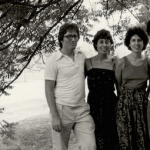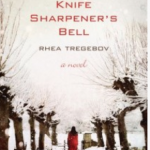Everyone’s a critic. Especially me. I write dance criticism. And, as a novelist and writing teacher, I’ve made an art of picking apart the most heartfelt, lovingly crafted prose. All of which means that when I read a novel by a friend, it’s like walking onto a minefield. What if I don’t like the book? Not that I’d ever come out and say it; I wouldn’t have to, for a heaviness – my disappointment and guilt for being disappointed, my friend’s detection of a lack of conviction in my praise – to afflict our most casual contacts. Go out for tea together? Why not just make it a glass of cyanide?
 Just so you know how fraught it was for me to read “The Knife Sharpener’s Bell” by Rhea Tregebov. I met Rhea in the mid-1970s on a visit to Cornell, where she was going to school. We clicked immediately and stayed in touch for several years; this pic is from when Jack and I visited her in Toronto in 1981. (She’s on the right.) We shared news of our publications, in her case poetry and a picture book for kids. Then time passed, and we lost touch. Thanks to Facebook, we reconnected a few months ago, and I found out she had a novel, “The Knife Sharpener’s Bell.” I bought it on Kindle and – with excitement and trepidation – started to read.
Just so you know how fraught it was for me to read “The Knife Sharpener’s Bell” by Rhea Tregebov. I met Rhea in the mid-1970s on a visit to Cornell, where she was going to school. We clicked immediately and stayed in touch for several years; this pic is from when Jack and I visited her in Toronto in 1981. (She’s on the right.) We shared news of our publications, in her case poetry and a picture book for kids. Then time passed, and we lost touch. Thanks to Facebook, we reconnected a few months ago, and I found out she had a novel, “The Knife Sharpener’s Bell.” I bought it on Kindle and – with excitement and trepidation – started to read.
 The Gershons are a Jewish immigrant family in Winnipeg, their lives seen through the eyes of their daughter, Annette, who’s eight when the novel begins in the mid-1930s. Like all immigrants, Annette’s parents are full of dreams, though their dreams are unusual: dedicated left-wingers, they want to return to Ukraine and build the workers’ revolution. But no one went back to eastern Europe! And I looked forward to reading an immigrant story with a Canadian twist, told with Rhea’s poetic language. (She’s a prize-winning poet.)
The Gershons are a Jewish immigrant family in Winnipeg, their lives seen through the eyes of their daughter, Annette, who’s eight when the novel begins in the mid-1930s. Like all immigrants, Annette’s parents are full of dreams, though their dreams are unusual: dedicated left-wingers, they want to return to Ukraine and build the workers’ revolution. But no one went back to eastern Europe! And I looked forward to reading an immigrant story with a Canadian twist, told with Rhea’s poetic language. (She’s a prize-winning poet.)
The Gershons do, however, return to their native Odessa in this surprising, original novel. Against the backdrop of great historic events – the romance of Communism, harrowing episodes in World War II, and eventual disillusion with the Soviet state – Annette grows to be a forthright young woman, a budding architect whose passion for her art provides some of the book’s loveliest writing: “Since I was small, I’ve been hunting something in buildings: rightness, wholeness. … I don’t believe it’s just petit-bourgeous aestheticism, this craving for beauty, for integrity. If these human structures are made carelessly, made ugly, how do they honor the people who live among them? Why shouldn’t we love what we’ve made, why shouldn’t we take care making it?”
This novel is made with great love and skill, the characters textured and engaging. And the writing gleams with a poet’s compact, gemlike imagery, with just one exception-the title. “The Knife-Sharpener’s Bell” refers to the sound made by a knife-grinder when Annette was a child, that filled her with fear. The image didn’t resonate as I think it was intended to, but that’s a small quibble with this deeply realized novel.